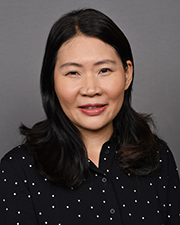
Sarah Xuelian Huang, MBBS, PhD
- Assistant Professor, IMM-Center for Stem Cell & Regenerative Medicine
Biography
Dr. Huang received her MB.B.S. from Xi’an Jiaotong University College of Medicine, Xi’an, China in 2000. She started to develop research interest in lung diseases when she joined the Master of Science program at Peking University Health Science Center, Beijing, China. She examined the inflammatory responses of rat alveolar macrophages to air pollution particulate matters collected in the urban area of Beijing. Dr. Huang received her PhD from Columbia University, New York, where she studied asbestos-induced responses in immune & inflammatory signaling of human small airway epithelial cells in the laboratory of Dr. Tom K. Hei from 2003 to 2009. Dr. Huang performed her postdoctoral training in Dr. Hans Snoeck’s Laboratory initially at Mount Sinai School of Medicine, New York, and later in Columbia University after Snoeck lab moved there. The main goal of Dr. Huang’s project was to establish a new model system for human lung disease studies. This new system was based on directed differentiation of hPSCs into specific organ cell types. Dr. Huang’s work was one of the first to rigorously and systemically demonstrate the generation of various lung and airway epithelial cell types directly from hPSCs with a particular enrichment in lower respiratory alveolar epithelial cells. Dr. Huang’s work further demonstrated the feasibility of this system for modeling infectious lung disease through collaboration with Dr. Jean-Laurent Casanova Lab at Rockefeller University. Utilizing the protocol, she developed, other research groups have successfully adapted the system for lung development or disease studies. In January 2017, Dr. Huang Joined the Center for Stem Cell and Regenerative Medicine (CSCRM) at the Brown Foundation Institute of Molecular Medicine (IMM) at UTHealth.
Areas of Interest
Research Interests
Realization of stem cell therapy in lung diseases relies on the successful generation of clinically applicable cell types. As a first, critical step in this direction, we have previously developed a step-wise differentiation strategy that directs human pluripotent stem cells (hPSCs) to become different types of upper and lower respiratory lung epithelial cells at large quantities. This differentiation platform was established based on advanced knowledge from animal developmental and genetic studies. It has been applied for lung development or disease studies by different research groups. However, for obtaining hPSC-derived lung epithelial cells with functionality and maturity suitable for clinical applications, we need to be able to understand lung developmental paradigm in greater details than currently possible. The main focus of our lab is to expand our knowledge on the mechanisms of lung lineage specification and tissue organization, and to use this knowledge for the development of innovative in vitro lung tissue models for studies of lung diseases and cell therapy. Currently, we are working on a model system for mapping the pathogen recognition patterns and the cellular and molecular responses of the lung epithelial cells to pathogen infection.
Publications
- Ya-Wen Chen, Sarah X.L. Huang, Ana L.R.T. Carvalho, Siu-Hong Ho, Mohammad N. Islam, Stefano Volpi, Luigi D. Notarangelo, Michael Ciancanelli, Jean-Laurent Casanova, Jahar Bhattacharya, Alice F. Liang, Laura M. Palermo, Matteo Porotto, Anne Moscona & Hans-Willem Snoeck. A three-dimensional model of human lung development and disease from pluripotent stem cells. Nat Cell Biol. 2017 May;19(5):542-549. doi: 10.1038/ncb3510. Epub 2017 Apr 24.
- Finn Hawkins, Philipp Kramer, Anjali Jacob, Ian Driver, Dylan C. Thomas, Katherine B. McCauley, Nicholas Skvir, Ana M. Crane, Anita A. Kurmann, Anthony N. Hollenberg, Sinead Nguyen, Brandon G. Wong, Ahmad S. Khalil, Sarah X.L. Huang, Susan Guttentag, Jason R. Rock, John M. Shannon, Brian R. Davis, and Darrell N. Kotton. Prospective isolation and single cell profiling of NKX2-1+/CD47+ human lung progenitors derived from pluripotent stem cells. Journal of Clinical Investigation, 2017 May 2. pii: 89950. doi: 10.1172/JCI89950.
- John O’neill, Brandon A. Guenthart, Jinho Kim, Scott Chicotka, Dawn Queen, Kenmond Fung, Charles Marboe, Alexander Romanov, Sarah X.L. Huang, Ya-Wen Chen, Hans-Willem Snoeck, Matthew Bacchetta and Gordana Vunjak-Novakovic. Cross-circulation for extracorporeal support and recovery of the lung. Nature Biomedical Engineering, 2017, 1, 0037 (2027).
- Michael Ciancanelli, Sarah X.L. Huang, Priya Luthra, Hannah Garner, Yuval Itan, Stefano Volpi, Fabien G. Lafaille, Céline Trouillet, Mirco Schmolke, Elisabeth Israelsson, Melina Herman, Tamar Hermesh, Lazaro Lorenzo, Randy A. Albrecht, Lawrence W. Leung, Satoshi Okada, Capucine Picard, Benedicte Ringuier, Françoise Troussier, Damien Chaussabel, Laurent Abel, Isabelle Pellier, Luigi D. Notarangelo, Adolfo García-Sastre, Christopher F. Basler, Frédéric Geissmann, Shen-Ying Zhang, Hans W. Snoeck and Jean-Laurent Casanova. Infectious disease. Impaired innate and intrinsic IFNα/β amplification underlies life-threatening influenza in human inherited IRF7 deficiency. Science, 2015, Apr 24;348(6233):448-53. doi: 10.1126/science.aaa1578. Epub 2015 Mar 26.
- Sarah X.L. Huang, Michael D Green, Ana Toste de Carvalho, Melanie Mumau, Ya-Wen Chen, Sunita L. D’Souza & Hans-Willem Snoeck. The in vitro generation of lung and airway progenitor cells from human pluripotent stem cells. Nature protocols. 10, 413–425, 2015. Published online, 05 February 2015 (doi:10.1038/nprot.2015.023).
- Sarah X.L. Huang, Mohammad Naimul Islam, John O’Neill, Zheng Hu, Yong-Guang Yang, Ya-Wen Chen, Melanie Mumau, Michael D Green, Gordana Vunjak-Novakovic, Jahar Bhattacharya & Hans-Willem Snoeck. Efficient generation of lung and airway epithelial cells from human pluripotent stem cells. Nat Biotechnology, 32, 84–91, 2014, Issue 1. (Advance online publication, Dec 1st, 2013. (doi:10.1038/nbt.2754).
- Michael D Green, Sarah X.L. Huang, Hans-Willem Snoeck. Stem cells of the respiratory system: from identification to differentiation into functional epithelium. Bioessays. 2013 Mar;35(3):261-70. doi: 10.1002/bies.201200090. Epub 2012 Nov 22.